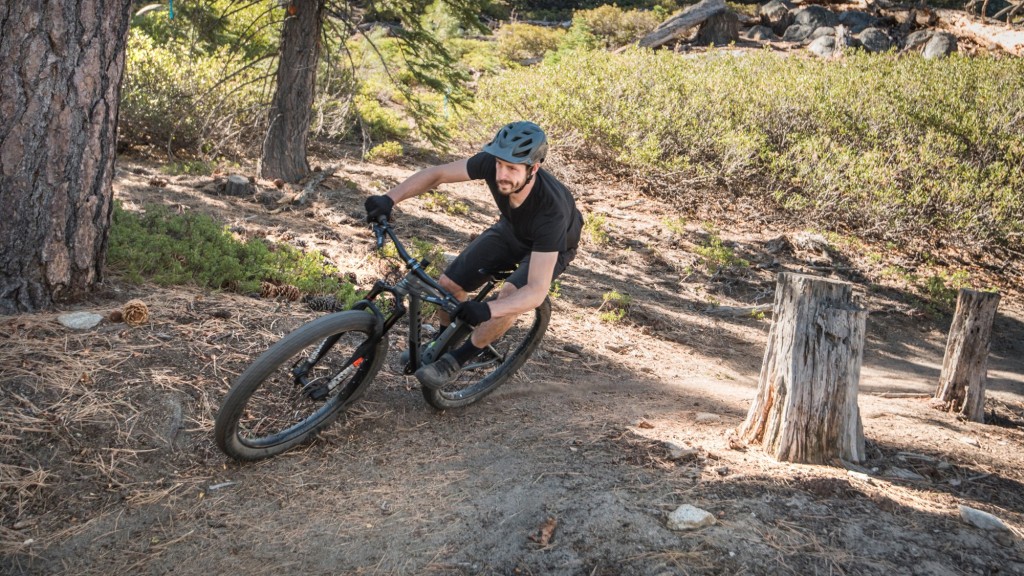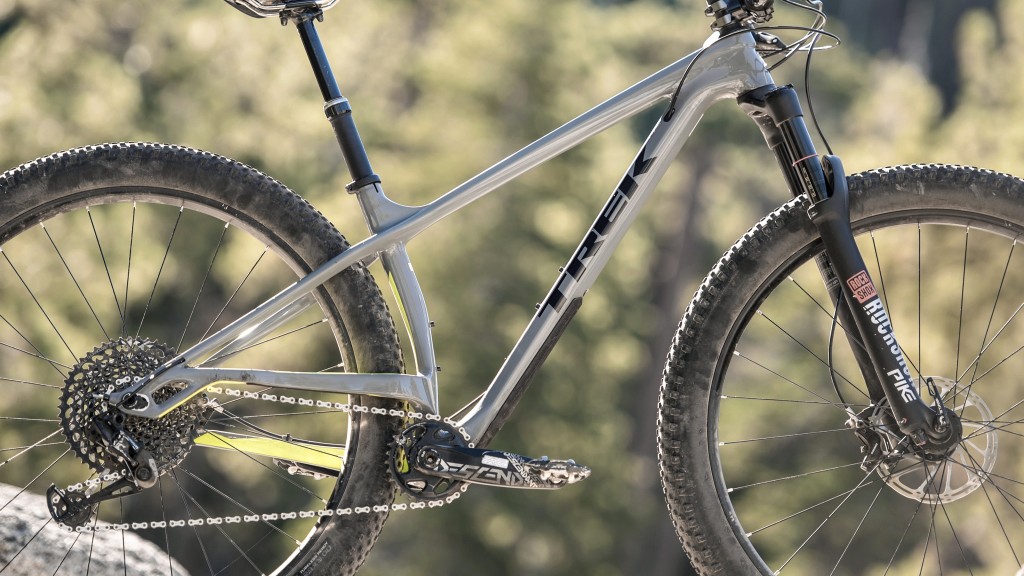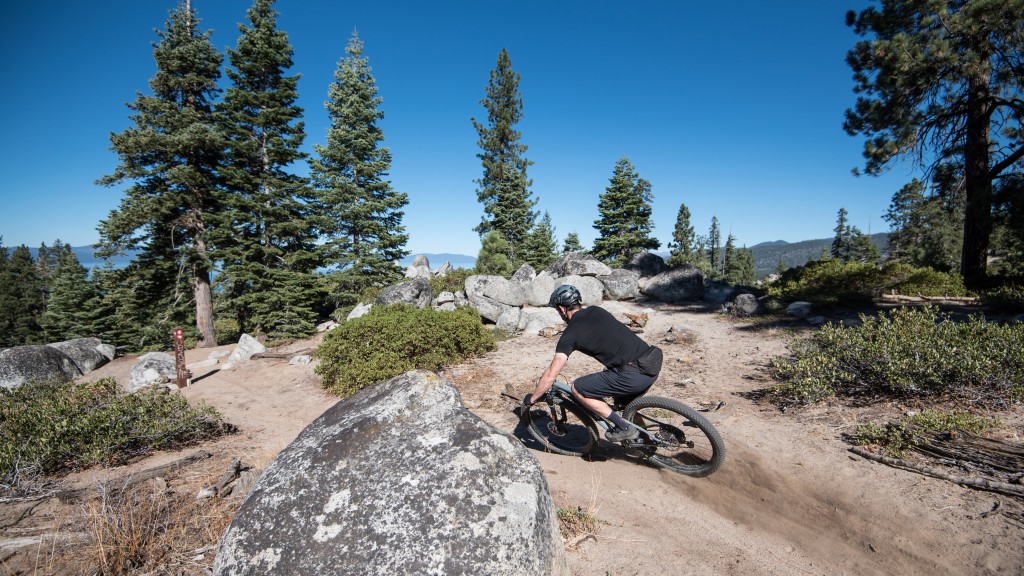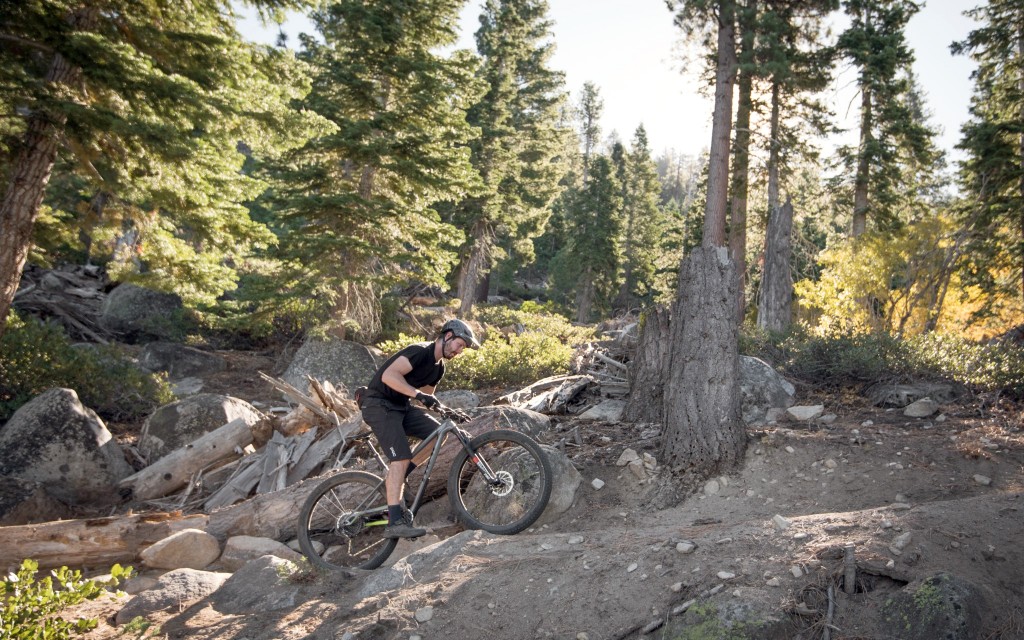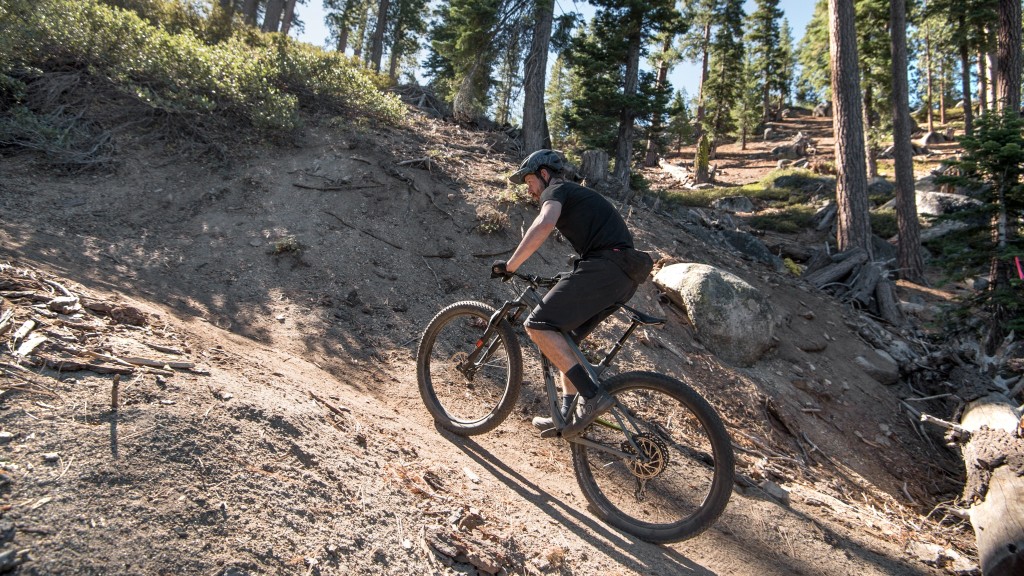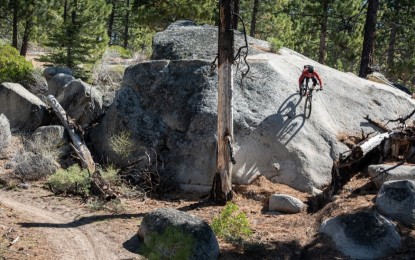Trek Stache 9.7 Review
Our Verdict
Our Analysis and Test Results
Should I Buy This Bike?
The Stache 9.7 is a lightweight and speedy hardtail. This bike is very good when ridden on the right terrain. Riders who want a cross-country inspired bike to cruise fast and relatively smooth trails will love the Stache. This bike is an excellent option for those embarking on frequent long-distance rides. This fast-rolling and efficient bike is very effective at covering ground with minimal effort. It is important to note that riders who encounter significant amounts of euro corners or tight switchbacks will have a tough time with these monstrous wheels. They simply feel too big and cumbersome in tight spaces. Additionally, if you plan on riding trails with any semblance of substantial rock gardens, you should look elsewhere. Seriously. The light and stiff frame with relatively upright cross-country geometry is brutal over rocks. For $3799, this bike boasts some nice components including a RockShox Pike and a GX Eagle drivetrain. Aluminum versions of this bike (with lesser components) start at $1889.
The Specialized Fuse 29 is a much more well-rounded hardtail that could easily be used as a daily driver. The Fuse cannot come close to matching the pure rolling speed and efficiency of the Stache and it's a few pounds heavier. Still, the Specialized is a far more comfortable bike. Descending over chatter is substantially more pleasant compared to the Stache. The aluminum frame of the Specialized is notably more forgiving than the Stache's carbon frame, and the modern geometry makes is a reasonably good climber and confidence-inspiring on the descents. We tested the $2,150 Expert 29 build and we feel it is the best hardtail we've ridden to date.
The Ibis DV9 is another lightweight carbon hardtail that is fast, efficient, and significantly less expensive than the Stache. The DV9 has a high-end carbon frame that delivers outstanding power transfer, and like the Stache that frame stiffness can feel a bit harsh over the especially rough stuff. The trade-off is the lively and spirited ride that can serve as an all-around trail bike or as an XC race rig. If you're keen on a bike like the Stache but don't want to spend $3,800, the DV9 NX hits a much more reasonable price point at $2,550 and has a build that won't disappoint.
Frame Design
The Stache 9.7 has a carbon fiber frame. In the Trek lineup, when you see a 9. in front of the model, that indicates a carbon construction. This bike runs 29 x 3.0-inch tires with Boost spacing. If the rear triangle looks funky, Trek's Midstay incorporates an elevated chainstay on the drive side of the frame. This helps create space to fit these massive wheels.
We measured our 17.5-inch (roughly a medium) test bike. It has a 614mm effective top tube with a 421mm reach. The chainstays are 423mm and the wheelbase measures a short 1120mm. The relatively steep head tube angle comes out to 68.0-degrees while the seat tube angle is a slack-ish 73.7-degrees. Our Stache hit the scales at a light 26 lbs 12 oz without pedals and set up tubeless.
Design Highlights
- Can be run geared or single-speed
- Designed around a 120mm fork
- 29 x 3.0-inch tires
- Boost spacing
- Internal routing
- Available in carbon or aluminum frames
Downhill Performance
The Stache 9.7 is a tale of two bicycles when aimed downhill. In certain situations, it operates at blistering speeds and delivers a speedy and fun ride. In other situations, the ride is ultra-rough and bone-rattling. Handling is sharp so long as the trail doesn't get too twisty. The bike responds well to rider input but can be a handful in tight spaces. Given the massive wheels, it shouldn't come as a surprise that the Stache isn't especially playful.
Descending can be extremely fun on the carbon Stache. It can also be brutal at times. Get the monster truck wheels rolling down a buff and relatively smooth ribbon of dirt, and this bike is completely in its element. The Stache is stable, confident, and very fast when it's in its happy place. As they say, big wheels keep on rolling and the Trek embodies this when motoring down (smooth) hills. When you encounter rock gardens, this bike is far less pleasant. No matter how soft you are with your knees and elbows to try to compensate for the lack of suspension, it is rough. Very rough. The 120mm RockShox Pike on the front of this bike creates a reasonably confident front end, but it is still a rough ride. Short rock gardens that you can sneak and finesse your way through are fine, but navigating longer, sustained, chop hurts. You can feel your organs shaking and it can be hard to breathe.
The moral of the story is that this bike requires the right terrain to be fun. It shouldn't come as a huge surprise that a carbon fiber hardtail, shies away from rougher terrain. That said, we have ridden some hardtails like the Specialized Fuse, Commencal Meta HT, and Rocky Mountain Growler that stand up much better to rough terrain.
Tire pressure is critical on the Stache. Too much air and you lose the damping benefit of the 3.0-inch tires. Too little air and cornering abilities get vague and washy. Our testers found the sweet spot to be in the range of 15-16 PSI.
The Stache's geometry delivers precise and sharp handling. The 68-degree head tube angle and short wheelbase allow this bicycle to steer quickly. The conservative geometry goes a long way to make this bike easy to ride. One thing to be careful of is the Bontrager XR2 tires, more on that in the discussion of the build kit section below, but the rubber does detract from confidence in corners. If the trail surface is a little loose or gravely, things can get sketchy. In addition, braking bite is heinous, as it takes about 50-feet to stop if you're going full speed.
The 9.7 has an impressive build kit, and it should at this price. The RockShox Pike is a nice specification. This stout fork has 35mm stanchions and the plush, yet, supportive Charger 2 damper is excellent. SRAM Guide R brakes offer enough power to shut the speed down. The Bontrager XR2 tires can be a little sketchy. These tires have poor braking bite. If you're carrying a full head of steam, it takes a lot of space to come to a full stop. Also, cornering abilities on gravely or loose trail surfaces are unreliable at best. There are essentially no shoulder knobs to rely on and they wash out quickly. Luckily, the sheer size of these tires dissuades you from leaning them over too far because it takes so much effort.
Climbing Performance
The Stache is an excellent climber. This light bicycle flies up smooth climbs with incredible ease. The lightweight frame, giant wheels, and GX Eagle drivetrain work together to minimize the rider's energy. Chunky climbs can present a problem by delivering a harsh ride and also overwhelming the grip of the XR2 tires which struggle in situations when you're standing and powering up loose climbs or rocks.
The Stache sets you up in a comfortable climbing position. The 421mm reach measurement is on the tighter side for a medium frame. The short reach puts you in an upright position. The 73.7-degree seat tube angle is slack-ish but somewhat standard for a hardtail. When seated, the bottom bracket is slightly in front of the rider's hips. Still, this bike is so efficient, the slack seat tube angle doesn't seem to detract from performance. Not to be overlooked, the sub-27 pound weight of our test bike really translates to climbing efficiency.
Tire pressure plays a big role on the climbs. Lower tire pressures will provide more grip and compensate for the questionable tire tread. Too low and you will start to feel a little bit of a bounce with every seated pedal stroke. Again, we found that 15-16 PSI tends to deliver the best balance.
Rollover ability is the name of the game with this bike. It does take a little longer than usual to get the Stache up to speed due to the giant 29 x 3.0-inch wheels. Once you have a head of steam, this bike simply mows down obstacles. It may not always be comfortable, but this bike cruises right up and over most rocks and roots. This is especially true on straighter sections of trails when the big wheels can run straight and fast.
Climbing up technical pitches can be uncomfortable. Trying to sit down and pedal through technical terrain is painful. With the 423mm chainstay tucking that rear axle right underneath you, you feel every single rock. It's best to stand up and grind it out while paying attention to not let the rear tire spin out under pedaling load.
Uphill handling is solid aboard the Stache 9.7. The short wheelbase paired with the steep-ish head tube angle creates a quick steering bike that can change lines in a hurry. If you find yourself on an undesirable line, you can quickly correct the mistake. The one quirk to the massive wheels is that they can be a little awkward to lift up and over a step or obstacle in the trail. Given the sheer mass, it takes some getting used to how to lift the front end of this bicycle.
The component grouping works well on the ascent. The SRAM GX Eagle drivetrain paired with the lightweight frame creates an easy and energy-saving climb. It takes an amazingly little amount of energy to get up familiar climbs. The Bontrager XR2 is unreliable on mixed terrain. The lack of tread makes it roll fast but it doesn't hook up well under standing pedaling loads and has a tendency to spin out on loose or gravel-y soil types.
Photo Tour
Value
At $3799 the Stache 9.7 is the most expensive hardtail in our test. We still feel it is a decent value considering the carbon frame and high-end build. On one hand, it delivers high-end performance within its intended application while offering good components. On the other hand, this bike is fairly one dimensional given the narrow range of trails on which it's fun.
Conclusion
The Trek Stache 9.7 rolls fast, climbs well, and racks up the miles amazingly quickly. Indeed, this is a very good bike on smooth, fast, and flowing terrain. As fun as this bike is on the right terrain, it is absolutely brutal on the wrong terrain: chatter and tight corners. Riders looking for a comfortable daily driver should look elsewhere. Riders looking for a simple and fast second bike might find their match with the Stache.



